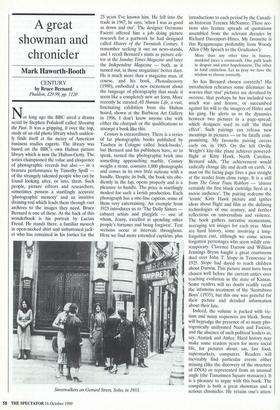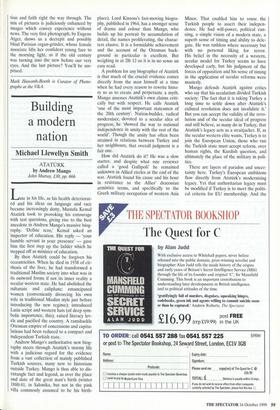A great showman and chronicler
Mark Haworth-Booth
CENTURY by Bruce Bernard Phaidon, 429.99, pp. 1120
Not long ago the BBC aired a drama serial by Stephen Poliakoff called Shooting the Past. It was a gripping, if over the top, study of an old photo library which sudden- ly finds itself at the mercy of American business studies experts. The library was based on the BBC's own Hu1ton picture library which is now the Hulton-Getty. The series championed the value and eloquence of photographic records but also — in a bravura performance by Timothy Spell — of the strangely talented people who can be found looking after, or into, them. Such people, picture editors and researchers, sometimes possess a startlingly accurate 'photographic memory' and an intuitive divining-rod which leads them through vast archives to the images they need. Bruce Bernard is one of these. At the back of this wonderbook is his portrait by Lucian Freud. He stands there, a familiar mensch in open-necked shirt and unbuttoned jack- et who has remained in his forties for the 25 years I've known him. He fell into the trade in 1967, he says, 'when I was as good as down and out'. The designer Germano Facetti offered him a job doing picture research for a partwork he had designed called History of the Twentieth Century. I remember seeking it out on news-stands, and I recall Bernard's stints as picture edi- tor at the Sunday Times Magazine and later the Independent Magazine — both, as it turned out, in those magazines' better days. He is much more than a magazine man, of course, and his book, Photodiscovery (1980), embodied a new excitement about the language of photography that made it seem like a completely new art form. More recently he curated All Human Life, a vast, fascinating exhibition from the Hu1ton hoard, shown at the Barbican Art Gallery in 1996. I don't know anyone else with either the chutzpah or the qualifications to attempt a book like this.
Century is extraordinary. There is a series of fat photographic books published by Taschen in Cologne called 'brick-books', but Bernard and his publishers have, so to speak, turned the photographic brick into something approaching marble. Century weighs a stone, contains 1,000 photographs and comes in its own little suitcase with a handle. Despite its bulk, the book sits obe- diently in the lap, opens properly and is a pleasure to handle. The price is startlingly modest for such a lavish production. Each photograph has a one-line caption, some of them very entertaining. An example from 1923 introduces us to The Dolly Sisters — cabaret artists and playgirls — one of whom, Jenny, excelled at spending other people's fortunes and being forgiven'. Text sections occur at intervals throughout. Here we find more extended captions, plus
Streetwalkers on Gerrard Street, Soho, in 1933. introductions to each period by the Canadi- an historian Terence McNamee. These sec- tions also feature spreads of quotations assembled from the relevant decades by Richard Davenport-Hines. My favourite is this Reaganesque profundity from Woody Allen (`My Speech to the Graduates'):
More than any other time in history, mankind faces a crossroads. One path leads to despair and utter hopelessness. The other to total extinction. Let us pray we have the wisdom to choose correctly.
So has Bernard chosen correctly? His introduction rehearses some dilemmas: he worries that 'star' pictures are devalued by overuse, that perhaps he has included too much war and horror, or succumbed against his will to the imagery of Hitler and his gang. He alerts us to the dynamics between two pictures in a page-spread, which designers used to call 'the third effect'. Such pairings can release new meanings in pictures — or be fatally com- promising. My favourite pairing occurs early on, in 1903. On the left Orville Wright's kite-like plane achieves powered- flight at Kitty Hawk, North Carolina. Bernard adds, 'The achievement would radically change life and death on earth.' A man on the facing page fires a gun straight at the reader from close range. It is a still from The Great Train Robbery — 'almost certainly the first blank cartridge fired at a movie audience'. The pairing redeems the 'iconic' Kitty Hawk picture and ignites ideas about flight and film as the defining technologies of our century, and further reflections on universalism and violence. The book gathers narrative momentum, averaging ten images for each year. Most are hard history, some involving a long. forgotten cast, although we come across forgotten personages who seem wildly con- temporary. Clarence Darrow and William Jennings Bryan fought a great courtroom duel over John T. Stope in Tennessee in 1925. Stope had dared to teach children about Darwin. This picture must have been chosen well before the current antics over teaching evolution in the state of Kansas. Some readers will no doubt readily recall the infamous treatment of the 'Scottsboro Boys' (1935), but this one was grateful for their picture and detailed information about their fate.
Indeed, the volume is packed with vic- tims and many sequences are bleak. Some will begrudge the presence of so many pho- togenically uniformed Nazis and Fascists, and the absence of such political leaders as, say, Atatiirk and Attlee. Hard history may make some readers yearn for more social life, for pictures about, say, fast food, supermarkets, computers. Readers will inevitably find particular events either missing (like the discovery of the structure of DNA) or represented from an unusual angle (the Tiananmen Square massacre). It is a pleasure to argue with this book. The compiler is both a great showman and a serious chronicler. He retains one's atten- tion and faith right the way through. The mix of pictures is judiciously enhanced by images which convey experience without news. The very first photograph, by Eugene Atget, shows us a decrepit and possibly blind Parisian organ-grinder, whose female associate lifts her confident young face to the morning light, as if the old century was turning into the new before our very eyes. And the last picture? You'll be sur- prised.
Mark Haworth-Booth is Curator of Photo- graphs at the V&A.



















































































 Previous page
Previous page